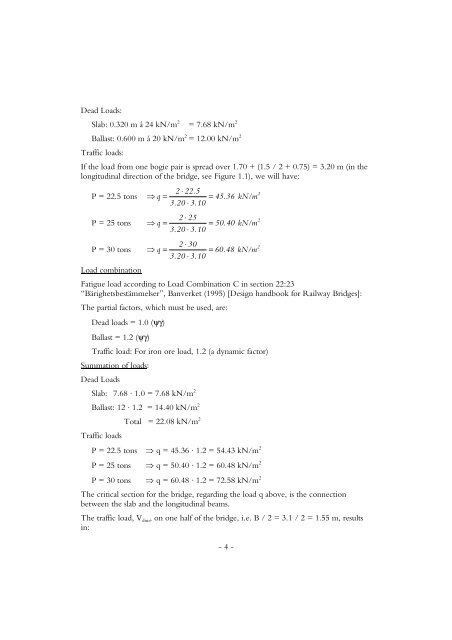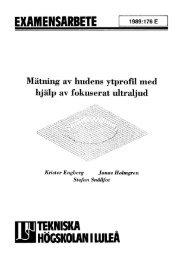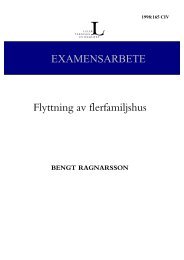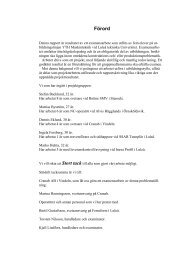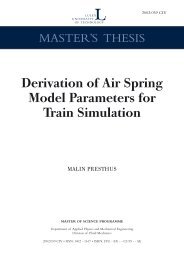LICENTIATE THESIS - Luleå tekniska universitet
LICENTIATE THESIS - Luleå tekniska universitet
LICENTIATE THESIS - Luleå tekniska universitet
You also want an ePaper? Increase the reach of your titles
YUMPU automatically turns print PDFs into web optimized ePapers that Google loves.
Dead Loads:<br />
Slab: 0.320 m á 24 kN/m 2 = 7.68 kN/m 2<br />
Ballast: 0.600 m á 20 kN/m 2 = 12.00 kN/m 2<br />
Traffic loads:<br />
If the load from one bogie pair is spread over 1.70 + (1.5 / 2 + 0.75) = 3.20 m (in the<br />
longitudinal direction of the bridge, see Figure 1.1), we will have:<br />
2 ⋅ 22.5<br />
2<br />
P = 22.5 tons ⇒ q = = 45.36 kN/m<br />
3.20 ⋅ 3.10<br />
2⋅25 2<br />
P = 25 tons ⇒ q = = 50.40 kN/m<br />
3.20 ⋅ 3.10<br />
2⋅30 2<br />
P = 30 tons ⇒ q = = 60.48 kN/m<br />
3.20 ⋅ 3.10<br />
Load combination<br />
Fatigue load according to Load Combination C in section 22:23<br />
“Bärighetsbestämmelser”, Banverket (1995) [Design handbook for Railway Bridges]:<br />
The partial factors, which must be used, are:<br />
Dead loads = 1.0 (ψγ)<br />
Ballast = 1.2 (ψγ)<br />
Traffic load: For iron ore load, 1.2 (a dynamic factor)<br />
Summation of loads:<br />
Dead Loads<br />
Slab: 7.68 · 1.0 = 7.68 kN/m 2<br />
Ballast: 12 · 1.2 = 14.40 kN/m 2<br />
Total = 22.08 kN/m 2<br />
Traffic loads<br />
P = 22.5 tons ⇒ q = 45.36 · 1.2 = 54.43 kN/m 2<br />
P = 25 tons ⇒ q = 50.40 · 1.2 = 60.48 kN/m 2<br />
P = 30 tons ⇒ q = 60.48 · 1.2 = 72.58 kN/m 2<br />
The critical section for the bridge, regarding the load q above, is the connection<br />
between the slab and the longitudinal beams.<br />
The traffic load, V dim, on one half of the bridge, i.e. B / 2 = 3.1 / 2 = 1.55 m, results<br />
in:<br />
- 4 -


